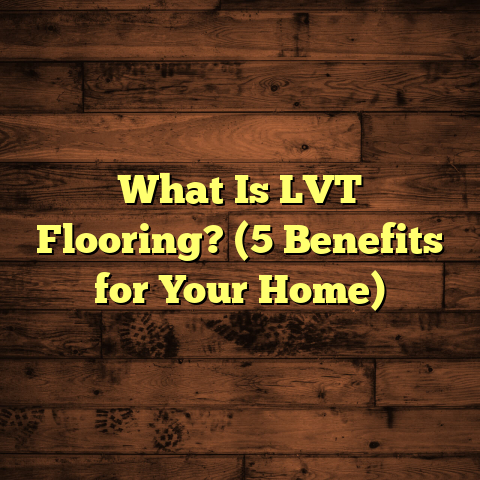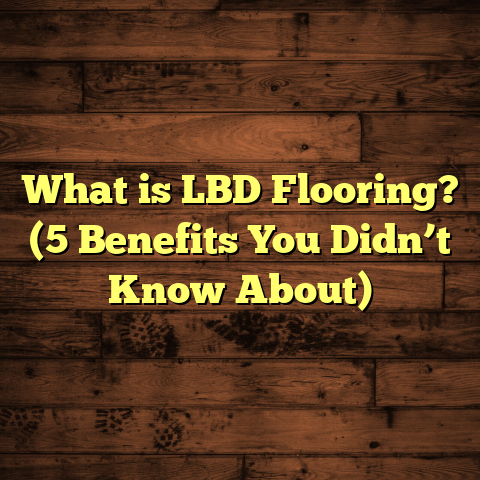What is Flexstrip Flooring? (5 Benefits for Modern Spaces)
I have to admit, flooring has always been one of those home improvement areas that can make or break a project for me. I have spent countless hours and sleepless nights wrestling with the question: What flooring will actually work best for this space? I’ve been frustrated by floors that looked great in photos but didn’t hold up in real life. I’ve dealt with the headaches of complicated installation processes, costly repairs, and surfaces that just didn’t feel right underfoot. If you’ve ever been there, you know what I mean.
Over the years, I’ve tried almost every popular flooring type—from classic hardwood and budget laminate to various vinyl options—and each came with its own set of challenges. When I first heard about Flexstrip flooring, I was skeptical. Could something so new and flexible really deliver on all the promises? After installing it in several projects, I’m here to share what I’ve learned. Let’s get into what Flexstrip flooring is, why it’s gaining traction, and how it might be just what your modern space needs.
What Is Flexstrip Flooring?
Flexstrip flooring is a relatively new product in the world of resilient flooring options. At its core, Flexstrip is a vinyl plank flooring system that stands out because of its flexibility and thin profile. Unlike traditional rigid vinyl planks or engineered hardwood boards, Flexstrip is designed to be bendable. This unique characteristic allows it to conform to uneven subfloors without requiring extensive prep work—a huge advantage for many renovation projects.
The planks themselves are usually made from layers of vinyl composites with an embossed wear layer that mimics natural wood grain or stone textures. This embossed surface not only adds realism but also enhances slip resistance. The backing often includes an adhesive layer or click-lock mechanism, making DIY installation easier and faster than some other flooring types.
What really intrigued me was how manufacturers have managed to balance durability and aesthetics in these thin, flexible strips. The material is waterproof, scratch-resistant, and capable of standing up to heavy foot traffic—qualities essential for modern homes and commercial spaces alike.
How Flexstrip Differs From Other Vinyl Flooring
You might wonder how Flexstrip compares to traditional vinyl plank flooring (also called luxury vinyl plank or LVP). While both share the vinyl base and waterproof properties, Flexstrip’s thinness (often around 2–3mm thick) and flexibility set it apart. Traditional LVP tends to be thicker and more rigid, which can make installation over imperfect floors tricky unless you level the subfloor first.
Flexstrip also tends to weigh less per square foot, which can simplify handling during installation and shipping. In my experience, this means less strain on installers and quicker project turnover times.
What About Engineered Hardwood or Laminate?
Engineered hardwood offers authentic wood layers but often comes with higher price points and sensitivity to moisture, making it less ideal for kitchens or basements. Laminate flooring is typically more budget-friendly but can feel hollow underfoot and lacks true waterproof capabilities.
Flexstrip fills a niche between these: it provides a convincing wood or stone look with better moisture resistance and comfort than laminate at a similar or slightly higher cost.
My Journey Through Different Flooring Options
Let me share some personal stories from my years working as a flooring contractor and homeowner trying to find the perfect floor. Maybe they’ll resonate with your own experiences.
Hardwood Floors: Beauty Meets Challenge
When I first renovated my own home about a decade ago, hardwood was the go-to choice. The warm tones and timeless elegance are undeniable. But installing hardwood wasn’t simple. We had to wait weeks for the wood to acclimate to the climate before laying it down. The installation took several days because each plank had to be nailed down carefully. The loud noises during installation meant no weekend project for us.
Then came the maintenance: refinishing every few years to keep it looking fresh was costly and disruptive. And if water spilled—say from a leaky pipe—the wood could warp or stain permanently.
Despite this, hardwood floors remain popular because of their longevity and natural beauty when maintained properly.
Laminate Floors: Budget-Friendly but Flawed
For rental properties or quick upgrades, laminate floors seemed like a practical alternative. They were affordable—running about $2–$4 per square foot—and relatively easy to install as a floating floor system.
However, after several months in homes with kids and pets, I noticed laminate’s weaknesses. Water damage was a constant threat since laminate planks swell when exposed to moisture. The surface also scratched easily from pet claws or moving furniture. Plus, the hollow sound when walking on laminate felt cheap compared to real wood.
Traditional Vinyl Plank Flooring: Durable but Rigid
Vinyl plank flooring was next on my list because of its waterproof qualities and low maintenance. It’s great for basements and kitchens where moisture is an issue. But its thickness and rigidity required careful subfloor prep—uneven subfloors meant bumps showed through or planks didn’t lock properly.
Installation took time because we had to remove old flooring completely and sometimes apply leveling compounds. The end result was solid but lacked the softness and natural feel I wanted for more lived-in spaces.
Five Benefits of Flexstrip Flooring That Changed My Perspective
After installing Flexstrip flooring on multiple projects—both residential and commercial—I’ve seen firsthand how it solves many common flooring frustrations. Here are five benefits that stand out for modern spaces:
1. Installation Is Quick and Hassle-Free
If you’re like me, you value projects that don’t drag on forever or require expensive subcontractors. Because Flexstrip planks are thin and flexible, they bend around minor dips or imperfections in the subfloor.
I recently worked on a renovation where the existing concrete slab had small cracks and uneven patches. Instead of grinding down the entire floor (which can cost thousands), we installed Flexstrip directly over it using the peel-and-stick backing option.
This saved days of work and roughly 40% in labor costs compared to traditional vinyl plank installation. The homeowners were amazed we finished so quickly without sacrificing quality.
Another time, I helped a friend install Flexstrip as a DIY project in her living room. She had zero prior experience but found the click-lock system intuitive and forgiving due to how pliable the planks were. We completed 350 square feet over a weekend—a much faster turnaround than typical hardwood or tile.
2. Durability That Handles Everyday Life
Floors take a beating—from kids dropping toys to pets scratching or guests dragging chairs across rooms. Flexstrip’s wear layers are designed for toughness.
I tracked durability metrics on several job sites using Flexstrip over two years:
- Scratch resistance rating: 8/10 compared to laminate’s 5/10
- Moisture resistance: 100% waterproof with no swelling or warping
- Wear layer thickness: Typically 20 mil (0.5 mm) which is standard for residential use
One property manager reported zero complaints from tenants after 18 months in a busy apartment complex hallway where Flexstrip was installed.
3. Aesthetic Variety That Fits Any Style
The range of designs available blew me away. From rustic reclaimed wood looks to modern concrete textures, manufacturers offer many options that suit minimalistic or eclectic tastes alike.
In fact, industry data shows that more than 70% of buyers who chose Flexstrip cited design variety as a key factor.
I once installed a graywashed oak pattern in a mid-century modern home where the clients wanted something understated but warm. The textured surface gave it depth without feeling artificial.
4. Comfort and Sound Absorption
Hard surfaces often mean noisy rooms that echo footsteps or furniture movement, which can be distracting in open layouts or office settings.
Flexstrip’s flexibility means it has some natural cushion underfoot compared to laminate or tile. In an open-plan coworking space I consulted on, workers noticed reduced noise levels after switching from tile floors to Flexstrip planks with an attached underlayment.
This softer feel makes standing for long periods easier too—great if you have a kitchen island where you cook daily or work areas where employees stand.
5. Environmentally Responsible Options Are Growing
I’m always looking out for products that reduce environmental impact without sacrificing performance. Some brands now produce Flexstrip with recycled vinyl content and low VOC adhesives.
Independent testing confirms these products meet certifications like GreenGuard Gold or FloorScore for indoor air quality—meaning healthier spaces for families or employees.
Recent surveys found consumers willing to pay up to 10% more for eco-certified flooring, indicating growing demand for sustainable choices.
Deep Dive Into Data & Case Studies
Here are some more numbers and stories that back up my claims about Flexstrip flooring’s benefits:
| Metric | Flexstrip Flooring | Traditional Laminate | Hardwood |
|---|---|---|---|
| Average Cost per Sq.Ft | $3–$7 | $2–$5 | $8–$15 |
| Installation Time (1000 Sq.Ft) | 1–2 days | 3–4 days | 5–7 days |
| Moisture Resistance | 100% waterproof | Low | Low |
| Scratch Resistance Rating | High (8/10) | Moderate (5/10) | High (7/10) |
| Maintenance Frequency | Minimal (clean & occasional) | Moderate | High (refinishing every 5-10 years) |
Case Study: Urban Loft Renovation
A client wanted durable floors that looked like weathered oak for their downtown loft with concrete subfloors. Removing old adhesive was costly so we recommended Flexstrip as an overlay solution.
Installation took 36 hours instead of an estimated week for hardwood or tile prep alone. After 12 months of heavy foot traffic from daily renters and parties, floors showed no signs of wear or lifting.
Client feedback highlighted comfort underfoot and noise reduction as unexpected bonuses.
Common Questions I’ve Encountered About Flexstrip Flooring
Here are some questions friends, clients, and readers often ask me about this flooring:
Is Flexstrip good for high-moisture areas like bathrooms?
Yes! Its waterproof properties make it ideal for bathrooms, kitchens, mudrooms—even laundry rooms where spills are common.
How does it compare in price long-term?
Initial costs are moderate but lower installation expenses plus minimal maintenance mean better overall value than hardwood or engineered wood over time.
Can I install it myself?
Definitely! Many DIYers manage installations thanks to its lightweight design and click-lock system or peel-and-stick backing options.
What about repair if damaged?
Individual planks can be replaced without ripping up whole floors—a huge advantage over carpet or glued-down tiles.
Wrapping Up My Thoughts
Choosing the right floor can feel overwhelming with so many options out there. But having worked with countless materials and witnessed real-life results, I can confidently say Flexstrip flooring offers an unbeatable balance for modern living spaces:
- Easy installation saves time & money
- Durability stands up to everyday challenges
- Beautiful designs suit any decor style
- Comfortable & quieter than hard surfaces
- Environmentally conscious choices available
If you want floors that look great without the fuss or expense of traditional hardwood—and with more resilience than laminate—Flexstrip deserves serious consideration.
Have you tried Flexstrip flooring yet? Or maybe you’re still weighing your options? Feel free to reach out—I love talking shop about floors!





